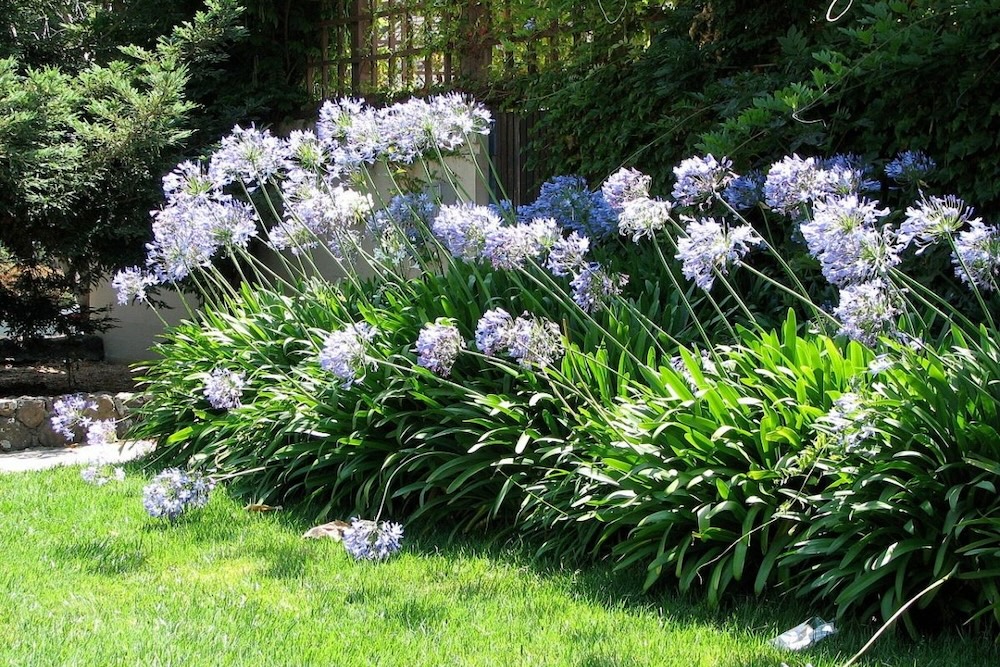Agapanthus Expanding Problems: Soil, Sunlight, and Watering
Agapanthus Expanding Problems: Soil, Sunlight, and Watering
Blog Article
Understanding the Art of Agapanthus Care: Necessary Actions for Healthy Development and Lively Blossoms
In the realm of cultivation, the cultivation of agapanthus stands as a fulfilling undertaking for those that seek to nurture these stylish flowering plants. With their striking flowers and graceful foliage, agapanthus has captured the interest of garden enthusiasts worldwide. However, accomplishing optimal growth and vibrant blossoms requires a nuanced approach that incorporates various vital actions. From choosing the ideal selection to understanding pruning strategies, the journey in the direction of cultivating flourishing agapanthus plants is multifaceted and holds the essential to unlocking the complete possibility of these agricultural gems.

Selecting the Right Agapanthus Variety

When picking the appropriate Agapanthus variety for your yard, consider elements such as environment viability, blossom shade, and growth behavior. Additionally, consider the environment in your region to guarantee the Agapanthus selection you pick can thrive in your specific conditions. Understanding the development practice of various Agapanthus varieties is essential for proper placement within your yard.
Perfect Growing Conditions
Considering the ideal ecological requirements is necessary for effective Agapanthus farming. Agapanthus thrives in well-draining soil with a somewhat acidic to neutral pH level. When growing, pick a place that obtains full sunshine to partial color. In hotter climates, giving some mid-day shade can stop scorching of the leaves. Agapanthus plants are sensitive to cold temperatures and ought to be safeguarded from frost during cold weather.
To guarantee healthy development and dynamic blooms, plant Agapanthus light bulbs at a deepness of concerning 2-4 inches and room them 8-12 inches apart. Mulching around the base of the plants aids keep wetness and reduces weed development.
Watering and Feeding Tips
Keeping appropriate wetness levels and offering crucial nutrients are crucial elements in the care regimen for Agapanthus plants. When it concerns sprinkling Agapanthus, it is vital to strike a balance. These plants choose constantly moist dirt but are susceptible to root rot if overwatered. During the expanding season, water deeply once a week, making certain the soil is well-draining to stop waterlogging. In hotter climates or throughout periods of drought, more constant watering may be required to keep the soil uniformly moist. Nonetheless, minimize watering in the winter season to stop water logged conditions.
Feeding Agapanthus is vital for advertising healthy growth and respected blossoms. Use a balanced fertilizer, such as a 10-10-10 formula, in the very early spring as brand-new development arises. By complying with these watering and fertilizing pointers, you can ensure your Agapanthus plants grow and find out here now generate dynamic, look these up resilient blooms.
Pruning Methods for Agapanthus
Pruning Agapanthus plants at the ideal times and with proper strategies is crucial for maintaining their wellness and advertising optimum development and blooming. The perfect time to prune Agapanthus is in late winter season or very early spring prior to brand-new development emerges. Begin by removing any yellowing or dead fallen leaves near the base of the plant. Cut them as short as possible without damaging the arising shoots.
For flowered stems, wait until the flowers have actually perished and after that trim them back to the base. This not just cleans the plant's look yet likewise urges the development of brand-new blossom buds. Deadheading spent blossoms can additionally reroute the plant's energy right into generating more flowers instead of setting seeds. However, if you intend to gather seeds for breeding, leave some blossoms to completely dry and fully grown on the plant.
Remember to utilize tidy, sharp devices to make specific cuts and reduce the threat of introducing diseases. Agapanthus. Regular trimming will certainly assist maintain your Agapanthus looking neat and healthy and balanced while ensuring a plentiful display of gorgeous flowers
Taking Care Of Usual Pests and Diseases
After making certain appropriate trimming techniques for Agapanthus, it is vital to address common bugs and conditions that can influence the wellness and vitality of these plants. Agapanthus plants are usually durable but can still succumb to specific issues. One usual insect that influences Agapanthus is the Agapanthus gall midget. This little, orange fly lays its eggs in the foliage, bring about distorted growth and blossom buds that fail to open up. To fight this bug, prune and damage any type of damaged plant components and think about utilizing insecticidal soap.
One more typical problem is fungal fallen leave area, which presents as dark lesions on the leaves. To protect against fungal illness, make certain good air blood circulation around the plants, stay clear of overhanging watering, and eliminate any kind of contaminated leaves promptly. Additionally, Agapanthus plants can suffer from origin rot if they are planted in inadequately draining dirt. To avoid this, plant Agapanthus in well-draining soil and avoid overwatering. By being alert and taking timely action versus pests and illness, you can help your Agapanthus plants thrive and produce vibrant blossoms.

Conclusion
Finally, mastering the art of agapanthus care entails choosing the best range, providing excellent growing conditions, appropriate watering and fertilizing, suitable trimming strategies, and attending to typical insects and conditions. By adhering to these crucial steps, you can guarantee healthy and balanced development and vibrant blooms for basics your agapanthus plants. Bear in mind to on a regular basis keep an eye on and preserve your plants to promote their general health and long life.
To ensure healthy and balanced development and vivid flowers, plant Agapanthus light bulbs at a deepness of regarding 2-4 inches and space them 8-12 inches apart. By following these watering and fertilizing suggestions, you can guarantee your Agapanthus plants flourish and generate vibrant, durable flowers.
One usual bug that impacts Agapanthus is the Agapanthus gall midget. In addition, Agapanthus plants can suffer from root rot if they are planted in inadequately draining dirt. By following these important actions, you can guarantee healthy development and dynamic flowers for your agapanthus plants.
Report this page